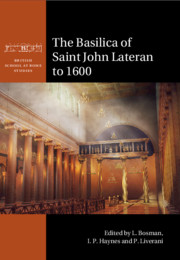Book contents
- The Basilica of Saint John Lateran to 1600
- British School at Rome Studies
- The Basilica of Saint John Lateran to 1600
- Copyright page
- Contents
- Figures
- Contributors
- Acknowledgements
- Abbreviations
- 1 The Lateran Basilica to 1600
- 2 The Evolution of the Lateran: From the Domus to the Episcopal Complex
- 3 At the Foot of the Lateran Hill, from Via Sannio to Viale Ipponio: Archaeological Investigations Prior to the Construction of Metro Line C
- 4 Ground-Penetrating Radar Survey in the Saint John Lateran Basilica Complex
- 5 The First Residential Phases of the Lateran Area and a Hypothesis to Explain the So-Called Trapezoidal Building
- 6 The Castra Nova and the Severan Transformation of Rome
- 7 Andrea Busiri Vici and the Excavations of 1876: A Reassessment of the Archaeological Evidence
- 8 Visualising the Constantinian Basilica
- 9 Constantine’s Spolia: A Set of Columns for San Giovanni in Laterano and the Arch of Constantine in Rome
- 10 The Constantinian Basilica in the Early Medieval Liber Pontificalis
- 11 The Lateran Baptistery in the Fourth and Fifth Centuries: New Certainties and Unresolved Questions
- 12 The Nymphaeum of Pope Hilarus
- 13 Examples of Medieval Construction Techniques in the Basilica of San Giovanni in Laterano
- 14 The Medieval Portico of Saint John Lateran
- 15 MATER ET CAPUT OMNIUM ECCLESIARUM: Visual Strategies in the Rivalry between San Giovanni in Laterano and San Pietro in Vaticano
- 16 The Remodelling of San Giovanni in Laterano by Pope Nicholas IV: Transept, Apse and Façade
- 17 Furtum Sacrilegum: The ‘Holy Heads’ of Peter and Paul and Their Reliquaries in the Lateran
- 18 Reconsidering the Traces of Gentile da Fabriano and Pisanello in the Lateran Basilica
- 19 The Rite of the Reconciliation of Penitents at the Lateran Basilica
- 20 The New Passion Relics at the Lateran, Fifteenth to Sixteenth Centuries: A Translocated Sacred Topography
- 21 The East Façade of the Complex of Saint John Lateran in the Modern Era
- 22 The Book of Acts in the Constantinian Basilica: Cardinal Cesare Baronio and the Navata Clementina in San Giovanni in Laterano
- Bibliography
- Index
11 - The Lateran Baptistery in the Fourth and Fifth Centuries: New Certainties and Unresolved Questions
Published online by Cambridge University Press: 27 August 2020
- The Basilica of Saint John Lateran to 1600
- British School at Rome Studies
- The Basilica of Saint John Lateran to 1600
- Copyright page
- Contents
- Figures
- Contributors
- Acknowledgements
- Abbreviations
- 1 The Lateran Basilica to 1600
- 2 The Evolution of the Lateran: From the Domus to the Episcopal Complex
- 3 At the Foot of the Lateran Hill, from Via Sannio to Viale Ipponio: Archaeological Investigations Prior to the Construction of Metro Line C
- 4 Ground-Penetrating Radar Survey in the Saint John Lateran Basilica Complex
- 5 The First Residential Phases of the Lateran Area and a Hypothesis to Explain the So-Called Trapezoidal Building
- 6 The Castra Nova and the Severan Transformation of Rome
- 7 Andrea Busiri Vici and the Excavations of 1876: A Reassessment of the Archaeological Evidence
- 8 Visualising the Constantinian Basilica
- 9 Constantine’s Spolia: A Set of Columns for San Giovanni in Laterano and the Arch of Constantine in Rome
- 10 The Constantinian Basilica in the Early Medieval Liber Pontificalis
- 11 The Lateran Baptistery in the Fourth and Fifth Centuries: New Certainties and Unresolved Questions
- 12 The Nymphaeum of Pope Hilarus
- 13 Examples of Medieval Construction Techniques in the Basilica of San Giovanni in Laterano
- 14 The Medieval Portico of Saint John Lateran
- 15 MATER ET CAPUT OMNIUM ECCLESIARUM: Visual Strategies in the Rivalry between San Giovanni in Laterano and San Pietro in Vaticano
- 16 The Remodelling of San Giovanni in Laterano by Pope Nicholas IV: Transept, Apse and Façade
- 17 Furtum Sacrilegum: The ‘Holy Heads’ of Peter and Paul and Their Reliquaries in the Lateran
- 18 Reconsidering the Traces of Gentile da Fabriano and Pisanello in the Lateran Basilica
- 19 The Rite of the Reconciliation of Penitents at the Lateran Basilica
- 20 The New Passion Relics at the Lateran, Fifteenth to Sixteenth Centuries: A Translocated Sacred Topography
- 21 The East Façade of the Complex of Saint John Lateran in the Modern Era
- 22 The Book of Acts in the Constantinian Basilica: Cardinal Cesare Baronio and the Navata Clementina in San Giovanni in Laterano
- Bibliography
- Index
Summary
Research of the Pontificio Istituto di Archeologia Cristiana on the Lateran Baptistery during the last two decades has resolved some of the many questions left open by the excavations inside the Baptistery in the 1920s and around it in the 1960s. This research has been coordinated by the author and Federico Guidobaldi and has involved the PIAC, the Swedish Institute of Classical Studies in Rome, the Vatican Museums and the Swedish National Heritage board. As a result it has been possible to determine the octagonal plan of the first (Constantinian) phase of the Baptistery, identify the foundations of the Oratory of Santa Croce, ascertain the height to which walls of the Constantinian phase are preserved, and deduce that the reconstructions attributed to the fifth-century Popes Sixtus III and Hilarus must be part of the same project.Laser scanned models and 3D documentation has been created as an instrument for research and for reconstructions. There remain, however, important, unresolved questions and these are also explored int his chapter.How was the building covered?Did it have an inner colonnade?What was the place of the first phase of this structure in the development of Late Antique architecture?
- Type
- Chapter
- Information
- The Basilica of Saint John Lateran to 1600 , pp. 221 - 238Publisher: Cambridge University PressPrint publication year: 2020



